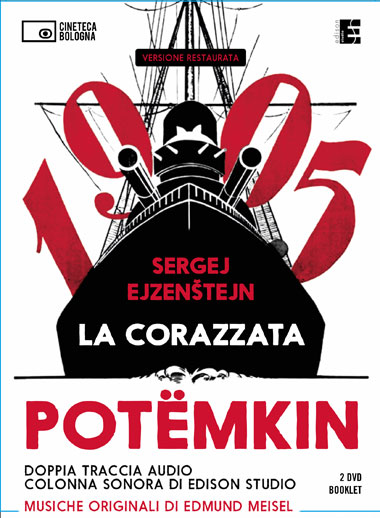
DVD – Battleship Potëmkin
Cineteca di Bologna
Year: 2017
2 DVDs with booklet (68’+119’ / 80 pages)
price: 16.90 €
directed by Ejzenštejn, Sergej (Eisenstein, Sergej)
Double Audio Track
– Soundtrack by Edison Studio, 2017 (DTS 5.1 and stereo tracks)
– Original Music by Edmund Meisel, 1925 (stereo track)
Languages: Russian, Italian subtitles
Buy the DVD at Cinestore of Cineteca di Bologna
The movie is presented in this DVD with 2 different Audio Tracks: a new electroacoustic soundtrack by Edison Studio (music by Luigi Ceccarelli, Fabio Cifariello Ciardi, Alessandro Cipriani in collaboration with Vincenzo Core) and the original score by Edmund Meisel adapted and directed by Helmut.
Imig![]() with the support of Società Italiana Autori ed Editori for the project “SIAE – classici di oggi”
with the support of Società Italiana Autori ed Editori for the project “SIAE – classici di oggi”
The film is presented with double audio track: a new electroacoustic soundtrack produced by Edison Studio (music by Luigi Ceccarelli, Fabio Cifariello Ciardi, Alessandro Cipriani in collaboration with Vincenzo Core) and the original score by Edmund Meisel in the adaptation and execution of Helmut Imig.
contents of the book
Unpublished essays by Peter von Bagh, Wu Ming 1, Emiliano Morreale, Roberto Chiesi. A conversation with Naum Kleiman, led by Bernard Eisenschitz. Voices on the Potëmkin: Léon Moussinac, Robert Desnos, Lewis Jacobs, Roland Barthes. The music of Potëmkin: Lothar Prox and Helmut Imig on the original score by Edmund Meisel, Giulio Latini on the electro-acoustic soundtrack of Edison Studio.
rarities and insights
On the trail of the Potëmkin battleship, documentary by Artem Demenok (2007); Cinema according to Ejzenštejn, a cinema lesson by Naum Kleiman; The battleship Potemkin in Italy. Versions in comparison, edited by Roberto Chiesi and Antonio Bigini; Actualités Pathé: Les Troubles de Saint-Pétersbourg (1905) and La Révolution en Russie (1905).
review
Potemkin’s enterprise
Let’s say it without fear. A beautiful film like “Battleship Potemkin” has not yet been made. A similar refined riot of highly advanced images, a similar enthralling homage to the revolutionary self-enhancement of the proletarian masses. Silent film. The unabridged version restored by Deutsche Kinemathek also incorporates the original soundtrack written by Edmund Meisel for piano and orchestrated by Helmut Imig in recent times. Written on the occasion of the Berlin premiere on April 24, 1926, four months after the premiere in Moscow.
Could one think of another soundtrack conceived according to the criteria and ideas that circulate in today’s “experimental” (multiform) music and that at the same time would create a soundtrack for a large part of the film?
To the point of letting us watch a sound film in the original language with Italian subtitles? It could have been done and Studio Edison accomplished the feat («Sergej Ejzenstein, The Potëmkin battleship», 2 DVDs, Meisel version and Studio Edison version, Ed. Cineteca di Bologna). Hired two Russian actors, captured their voices on texts taken from the original Russian captions, multiplied the computer voices for the choral scenes. Here is a real “new” Potemkin.
The hideous sadistic commander of the ship is heard shouting his invectives and his orders to execute the sailors who refuse to eat the spoiled meat. Vakulinchuk, the sailor leading the mutiny, is heard cheering on his comrades. Vakulinchuk who ends up killed and, ashore, in front of the port of Odessa, is celebrated as the hero of the revolution. The steps of the firing squad (which will not fire) on the deck of the ship and of the tsarist guards
who making a massacre of crowds on the steps. Perhaps the purists will have to say. But Studio Edison’s taste is perfect and the charm of this vision is overwhelming. And the music? The electro-acoustics that exist beyond the sound effects, which are very musical, of the actions performed in the film? Top notch. Drums, electric guitar, double bass, balafon, metal plates and digital treatments of recorded sounds. Splendid free percussive sequences, some glitchy reminiscences and an incredible inventiveness in the frenetic “jagged continuum” of the scenes where the battle against the tsarist fleet is prepared on the self-managed Potemkin. (But the sailors of the fleet, who have risen in turn, will let the brothers of the revolt pass).
Mario Gamba – Il Manifesto – ALIAS – 13 January 2018
